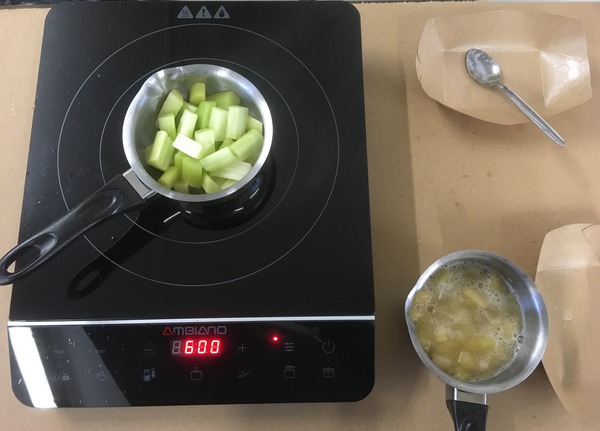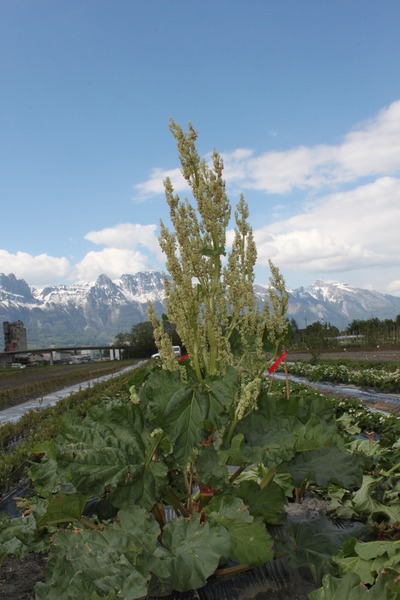 Frederik Vollert, Moritz Köhle and Maja Pfund from Lubera’s breeder team are currently taking over the Lubera kitchen at the end of April – to cook and taste rhubarb. This is a rather unusual picture: dozens of rhubarb bowls on the table, men and one woman standing around the rhubarb table discussing the finer points of rhubarb flavour. What is going on? The Lubera editorial team wanted to know more and asked the acid-minded rhubarb enthusiasts and rhubarb chef Frederik Vollert about their somewhat disconcerting activities: can you really taste rhubarb like wine and what does rhubarb actually taste like?
Frederik Vollert, Moritz Köhle and Maja Pfund from Lubera’s breeder team are currently taking over the Lubera kitchen at the end of April – to cook and taste rhubarb. This is a rather unusual picture: dozens of rhubarb bowls on the table, men and one woman standing around the rhubarb table discussing the finer points of rhubarb flavour. What is going on? The Lubera editorial team wanted to know more and asked the acid-minded rhubarb enthusiasts and rhubarb chef Frederik Vollert about their somewhat disconcerting activities: can you really taste rhubarb like wine and what does rhubarb actually taste like?
Frederik, please tell me, what are you actually doing here?
Quite simply, we are tasting new rhubarb varieties from the Lubera breeding programme.
How many rhubarb varieties will you taste?
There will be about 50 selections that we have shortlisted, that we have selected intensively and over several years in the field, and now we also want to taste test them. Of course, this is pure pleasure on the one hand, the diversity of colours and flavours excites us, but it also means hard work: in the end, this is rhubarb after all and it is quite sour overall. We have to remain attentive for over 50 varieties; we need to be open to new things, creative in our comparisons (of what the rhubarb tastes like...) and of course at the same time we have to be as objective as possible. Therefore, we have divided the tasting into several groups. We try to compare about 10 varieties each. And we can't get through that in one day, as that would overwhelm us and our taste buds.

Picture: Tasting rhubarb at 7:00 in the morning? No problem for chef Frederik Vollert...
Do you have reference varieties in addition to the Lubera cultivars?
Yes, of course, we do. We have a broad standard assortment for comparison, against which we can then not only classify the new varieties but also distinguish them. Ultimately, we are also looking for more diversity in terms of taste.
How did you cook the rhubarb?
We cook 100 g of rhubarb cubes cut into roughly the same size, together with 25 ml of water and with a teaspoon of sugar. We don’t cook the rhubarb pieces completely to mush, but so that they are still partially preserved.
Sugar? That's almost a dirty word these days...is that permissible? Doesn't it distort the flavour?
Rhubarb is hardly conceivable without sugar. Rhubarb as a stem vegetable and fruit only became an issue in the early 19th century (after 1800) when enough industrially produced sugar was available – and made the previously unknown rhubarb edible as a fruit. Before that, rhubarb was only used in medicine and it was not the stalks or leaves that were used, but the roots and rhizomes. They were supposed to help against constipation, among other things. So we think sugar is absolutely part of it, but only in relatively small amounts so that its own flavour comes into full effect and is not masked.

Picture: The rhubarb cubes, cut into approximately the same size, are distributed into the cups provided in front

Picture: Portions of the different rhubarb selections are cooked with water and very little sugar and then degustated
What do you evaluate and discuss first?
Of course, the colour is first, which is the most obvious and probably also the easiest to distinguish. With rhubarb, too, there is a feast for the eyes.
Are there different textures in cooked rhubarb?
No, we haven't really noticed that; except that rhubarb naturally cooks away at slightly different rates depending on the variety.
Which rhubarb cooks up better, and which take more time?
Large, thick and wide rhubarb stalks cook away a little faster; they have a looser structure and are a little less compact.
Now how is it with the acidity, are there really milder and more acidic rhubarb or is a rhubarb just...a rhubarb?
Yes, of course, the acidity and the intensity of the acidity is the first thing that stands out – and there are also clear differences between the variety candidates. That's why we use the same amount of sugar in all samples. Cooks would probably compensate for this in the household with more (or less?) sugar. Nevertheless, it is certainly worthwhile to also select rhubarb that has less acidity and therefore also needs less sugar for enjoyment.

Picture: True to the motto 'sour makes merry', these cooked rhubarb are waiting to be tasted.
Rhubarb has a “gritty” effect, leading to a somewhat special coating on the teeth. Does this experience vary in intensity depending on the variety or is it no longer possible to judge this after dozens of varieties?
In short: yes, the individual rhubarb selections differ in part already very much in how strongly this “gritty” feeling is pronounced. While individual selections may be quite similar, it is not said that these similar types are also tasted directly one after the other. So it's all the more exciting because we can't be sure what to expect before each new bowl.
Of course, our taste buds have to perform at their best in a very short time, and we can be overwhelmed by all the rhubarb. However, we do not taste all the rhubarb selections at once, but only about a dozen selections at a time, and then we take a break for a few hours. This interruption is good for the taste buds but we use the time to prepare and cook the next dozen selections.
Everyone who has eaten rhubarb knows that the “gritty” feeling in the mouth goes away all by itself after a while. And since we do the tasting as a team and we also have to agree on a common evaluation after each selection, we also have enough time for the grittiness to be largely gone by the next selection and thus not hinder our evaluations any further.
Does rhubarb have any flavour at all?
Sure, there is certainly the typical, fresh green rhubarb aroma that gives a rhubarb syrup or rhubarb juice (rhubarb spritzer!) the incomparable freshness. This would be quite suitable also as a morning wake-up drink, helping to awaken the spirits. This difficult to describe, “green”, resistant and yet at the same time also pleasant, recognisable and “learned” aroma can then be paired with additional citrusy nuances or it can also have fruity or even floral accents. We try to distinguish this and then describe it. This is no longer possible digitally or with scaling scores of 1-5 or 1-9, but only with textual descriptions. This is just like with wine. And as with wine, the nose also plays a decisive role, i.e. what we perceive retronasally via the sense of smell after enjoying the food and the perception of the taste buds (sweet/sour, astringency, bitterness).
Now you describe your taste and smell impression of the rhubarb selections from Lubera...But do you also evaluate? What is better, what is worse?
Good is what pleases us. And yes: it is very difficult to argue about taste and flavours. But in the end, it's all about the intensity of the individual components. Rhubarb can taste relatively “short” and boring. It is just rhubarb, nothing more; or it can have – to speak with wine language – a more intense or less intense climax, or a longer or shorter aftertaste. Of course, we are most interested in rhubarb selections with a greater intensity of flavour that is not based solely on a more or less intense acidity.
We have talked for a very long time about the taste and the aroma. What else is important in rhubarb breeding, what else have you looked at in rhubarb in recent years?
We try to look at the tasting results together with the agronomic results as a whole to come to an overall assessment. Here is what we looked at and collected with data:
- The colour of the stalks on the inside and outside
- For partially and fully coloured varieties, we are looking at how much they are coloured through and how early in the stalk development process they colour through
- The length and thickness of the stalks
- The number of stalks per plant; we have cultivar candidates that are absolute mass producers and regularly produce up to 80 and more stalks per rhubarb plant
- The early budding, the earliness of harvesting
- The growth character, upright, broad, the ratio of leaves and stalk length, the compactness, the stability of the stalks and leaves
- Rhubarb that produces no flowers or few flowers vs. rhubarb that produces a lot of flowers and still sprouts a lot of stalks
- How many harvests are possible, are two harvests possible in the spring?
- How does the rhubarb grow back in the summer and autumn, can it be harvested all year?
And how do you bring these so different results and data together?
In the end, we group rhubarb types by stalk colour, growth character, flowers/no flowers/a large amount of flowers, and then we try to find the best variety candidates within these groups via tasting.

How many different varieties do you think will eventually come out of this process?
Over the past few years in rhubarb breeding, we have learned that diversity in rhubarb is greater than originally thought. While some cultivars and cultivar groups are genetically close, we have taken care to include as diverse material as possible when selecting parent plants for breeding. Therefore, we are confident that in the end, we will have five to ten new rhubarb varieties that also bring new and exciting characteristics compared to standard varieties:
- Compact growth for pot and container cultivation
- More yield for harvesting and also for agricultural cultivation
- More and more colour-stable, red-fleshed varieties
- Rhubarb with ornamental value, developing a large number of flowers (up to 10 flower stalks) and still producing a good yield
- Rhubarb with more intense flavour, mild rhubarb, aromatic rhubarb
But now we have to stop fantasising and...continue eating rhubarb.
